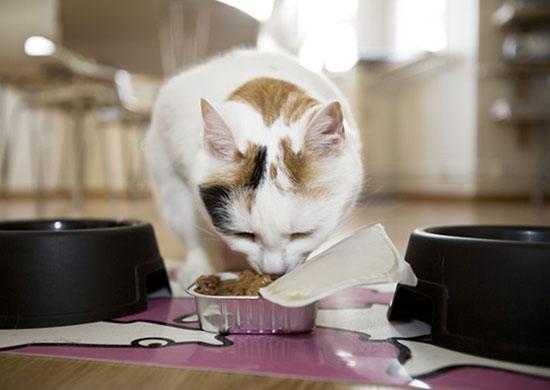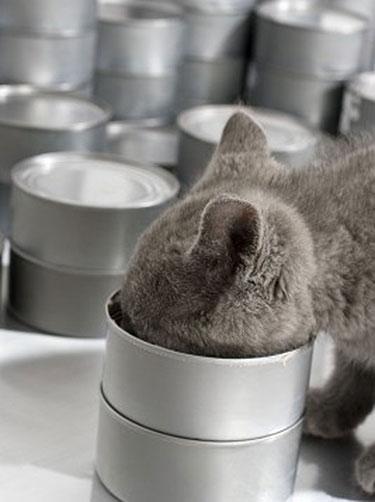This content is archived from the Feline Nutrition Foundation
Figuring Out the Carbs in Canned Cat Food
- Updated: Wednesday, April 24, 2019 03:38 PM
- Published: Tuesday, March 15, 2011 12:29 PM
- Written by Margaret Gates
 I'm in the process of switching my cats to a raw food diet. I've gotten them off of dry food and I'm now giving them a grain-free canned food. But I'm confused about the carbohydrate content. None of the canned foods I look at list carbohydrates on the label. Also, even though the canned food is grain-free there are vegetables in it! Isn't that just carbohydrates in a different form?
I'm in the process of switching my cats to a raw food diet. I've gotten them off of dry food and I'm now giving them a grain-free canned food. But I'm confused about the carbohydrate content. None of the canned foods I look at list carbohydrates on the label. Also, even though the canned food is grain-free there are vegetables in it! Isn't that just carbohydrates in a different form?
Many pet food manufacturers are catching on to the idea that people are avoiding cat foods with grain, so they are using other filler carbohydrates. While grain is especially bad for cats, sweet potatoes and peas aren't much better. Cats and carbs do not mix.
Cats use protein as their primary energy source. Most canned foods will have some ingredients that count as carbohydrates. Look for ones that have as little as possible. Some products will list ingredients on the label that look bad, such as cranberries or seeds, but the amounts may be tiny and may not contribute much in the way of carbohydrates. Other canned foods will have a great deal of filler vegetables. Unless you compare the carb content, you can't tell the difference between the two just by reading the ingredient list.
Carbohydrates usually aren't listed on the label, so we will have to figure it out. These calculations work for any kind of food that you have the numbers for: canned foods, raw cat food and even dry foods. The method I describe uses percentages from the label, which are by weight. Yes, you'll need a calculator.
Comparisons: Wet Matter vs Dry Matter Basis
 Add the percentages listed on the label for protein, fat, fiber, moisture and ash. Ignore the other listed amounts, as these will be for minerals included in the ash percentage or be so small as to not affect the calculation. Subtract this number from 100 to get the carb percentage on a wet matter basis.
Add the percentages listed on the label for protein, fat, fiber, moisture and ash. Ignore the other listed amounts, as these will be for minerals included in the ash percentage or be so small as to not affect the calculation. Subtract this number from 100 to get the carb percentage on a wet matter basis.
Example 1
Generic Label Cat Food
Crude protein – min 9.5%
Crude fat – min 5.0%
Crude fiber – min 0.8%
Moisture – max 75%
Ash – max 2.0%
This adds up to 92.3%. Subtracting from 100, you get 7.7% carbohydrate on a wet matter basis. This doesn't sound so bad, but we need to convert it to a dry matter basis in order to level the playing field. In this example, the food is 75% moisture, which is 25% on a dry matter basis. Divide 7.7% by .25 and you get 30.8%. On a dry matter basis, this example is almost 31% carbohydrate. Not good.
Example 2
Wellness® Turkey and Salmon canned, grain-free
Crude protein – min 10%
Crude fat – min 6%
Crude fiber – min 1%
Moisture – max 78%
Ash – max 1.8%
This works out to 3.2% carbs wet matter and 14.5% dry matter. Much better.
Example 3
Evo® 95% Chicken & Turkey canned, grain-free
Crude protein – min 9%
Crude fat – min 10%
Crude fiber – min 1%
Moisture – max 78%
Ash – max 1.91%
This works out to .09% carbs wet matter and .4% dry matter. Even better.
Additional Reading
Feeding Kitten Food to an Adult Cat
Feline Cystitis and Bladder/Kidney Stones
You can see that there is a great deal of variation in the carbohydrate content of canned foods. Keep in mind that the percentages listed on pet food labels are minimums and maximums, and may not really reflect what's in the can. Use them as a broad guideline only.
You can use this method to calculate the dry matter percentages of the other ingredients as well. For example, the dry matter percentages for protein of the three examples above are 38%, 45.5% and 41% respectively. These can be useful numbers to know when looking for a food that is higher in protein.
Note: Feline Nutrition provides feline health and nutrition information as a public service. Diagnosis and treatment of specific conditions should always be in consultation with your own veterinarian. Feline Nutrition disclaims all warranties and liability related to the veterinary advice and information provided on this site.
Margaret Gates is the founder of the Feline Nutrition Foundation.




